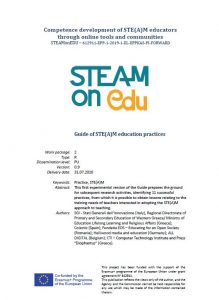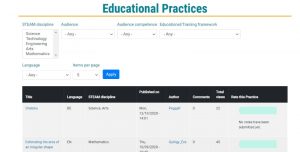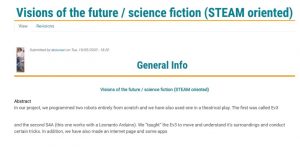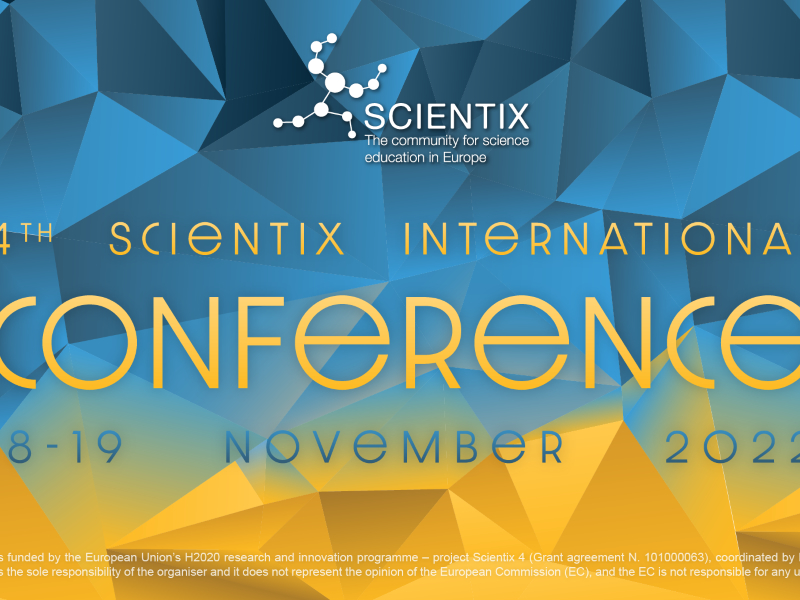A Guide of STE(A)M Education Practices

 The STEAMonEdu project consortium has prepared a Guide of STE(A)M Education Practices for subsequent research activities, identifying 11 successful practices, from which it is possible to obtain lessons relating to the training needs of teachers interested in adopting a STE(A)M approach to teaching.
The STEAMonEdu project consortium has prepared a Guide of STE(A)M Education Practices for subsequent research activities, identifying 11 successful practices, from which it is possible to obtain lessons relating to the training needs of teachers interested in adopting a STE(A)M approach to teaching.
As a result of research and creative techniques that will be instrumental among the members of the community, the STE(A)M education framework will include competences, policies, methodologies, and educational objects.
In line with the STEAMonEdu project, this first version of the guide is also intended to fuel discussion among our community members, providing them with examples, ideas and a baseline for benchmarking their own practices and projects.
The aim is to summarize and evaluate good and not so good STE(A)M education practices, based on local and regional initiatives that support STEM and STE(A)M education.
The online platform
From the beginning of the project, the STEAMonEdu community members could join an online platform where good practices have been collected. Any person interested in joining the community can check it out and register.
The online community will be open during and after the project. It is a very useful tool to share and learn about other’s educational experiences.
25 evaluation criteria and principles that characterize a STE(A)M practice
The STEAMonEdu project refers to a “Good practice” such training and education initiatives that are built and implemented by schools, NGOs, and any education provider, incorporating some principles, including inclusive STEAM education, problem-based learning or integrated learning system.
Also, at the beginning of the project, partners agreed on 25 evaluation criteria based upon the principles listed in the previous section. Each criterium has been scored from 0 (not valuable) to 3 (good), the maximum score attainable by a practice being then 75. Practices scoring over 65 are considered best practices.
Moreover, to be considered a STE(A)M practice, the practice should include Arts among the disciplines involved.
A list of educational and policies practices
Up to this moment, the platform has collected around 65 educational practices and 18 policies and any kind of implementations in the context of STE(A)M education.
The educational practice was split in five parts, to facilitate information input:
- General Info, which includes the basic data of the practice, namely, title, language, abstract, STE(A)M area/topic of use in the practice, key terms, license information and any related source.
- Author, presenting the leading author’s name, capacity and affiliation, together with names of any co-authors.
- Audience and Educational Framework, where the characteristics of the targeting audience are provided (capacity, age range, competence) as well as the educational framework where this practice was designed and/or used for.
- Educational Details, where the specific data of the practice are provided, i.e. the teaching topic where the practice was applied, its duration, difficulty, learning outcomes and specific use, the orientation/focus, the delivery mode, the pedagogical theory/mode/strategy followed, the necessary resources to be applied, and a full textual description that can be accompanied by any resources (documents or URLs).
- Implementation, that is used to record data regarding the application of the practice, such as the country and organization, the type of education and audience size as well as details about the evaluation (if any) and the lessons learned by the application.
Similarly, educational policies are uploaded by the project partners that we can can organized in three parts:
- General Info, which includes all the primary fields of interest that provide the identity of the practice, namely, the title, language, purpose, the key terms, the country and authority that issued the policy and a source (text or URL) that points to the original policy.
- Applicability and audience, which includes specific information of the target audience, the coverage (applicability area) and the educational framework that the policy was created for.
- Details, which allows a brief or extensive description of the policy (reason, implementation procedures, implementation structures, definitions) as well as monitoring and evaluation that is applied, related policies and the help desk (cognizant office) that can provide further details, if necessary.
We invite you to view it and delve into the contents of the guide, to participate in the forums discussion and to upload your contents! Let’s make the community!
By Colectic





